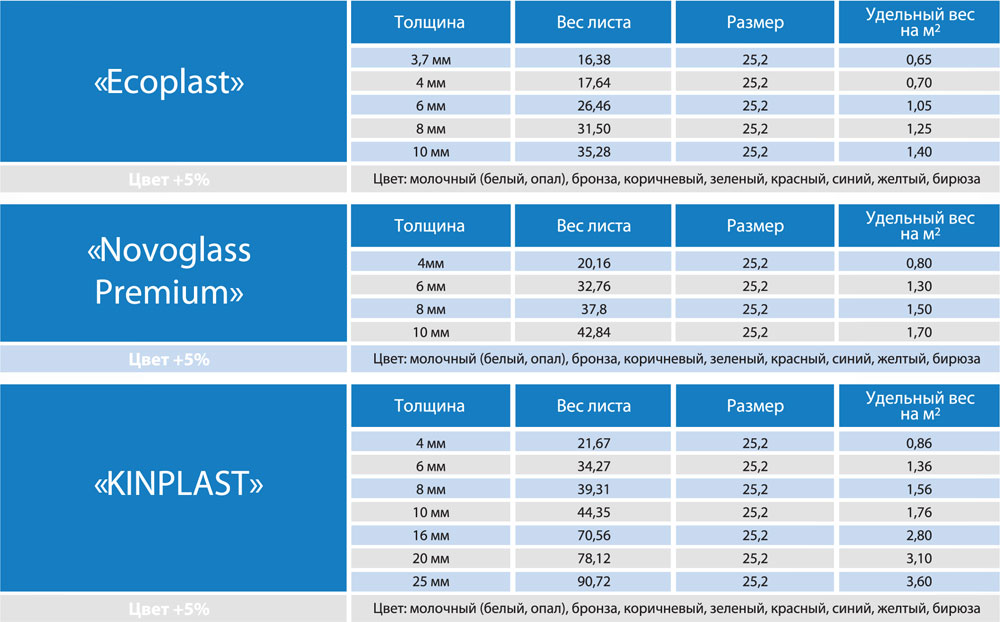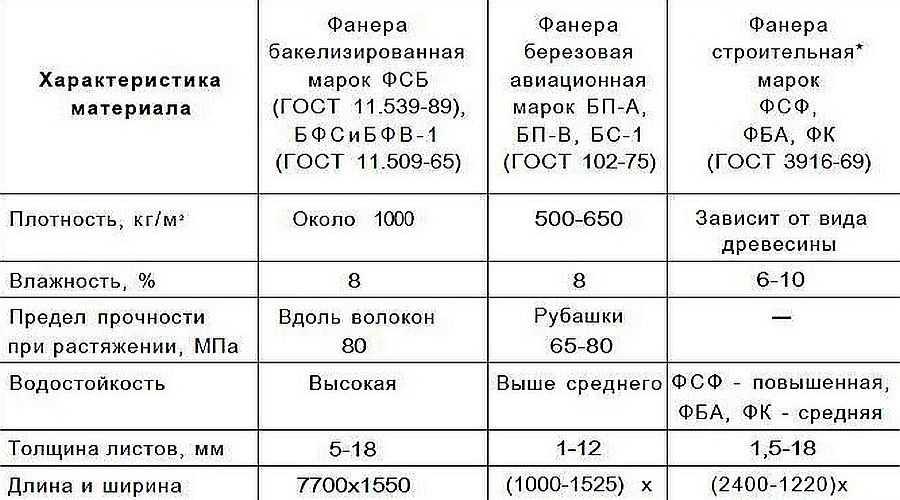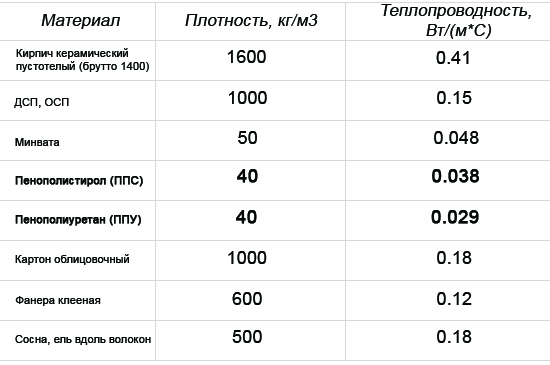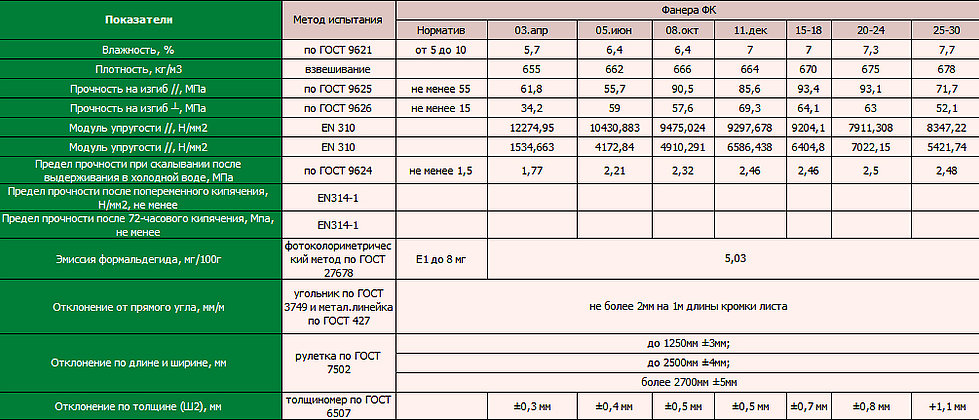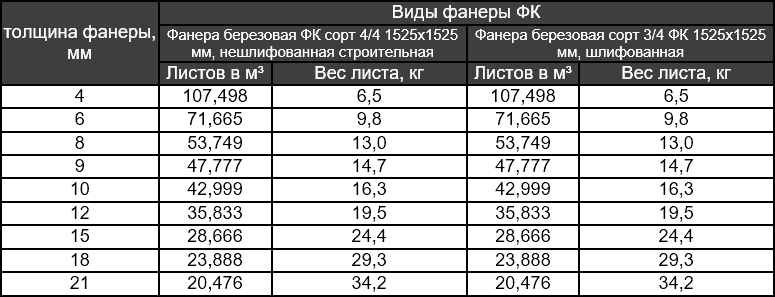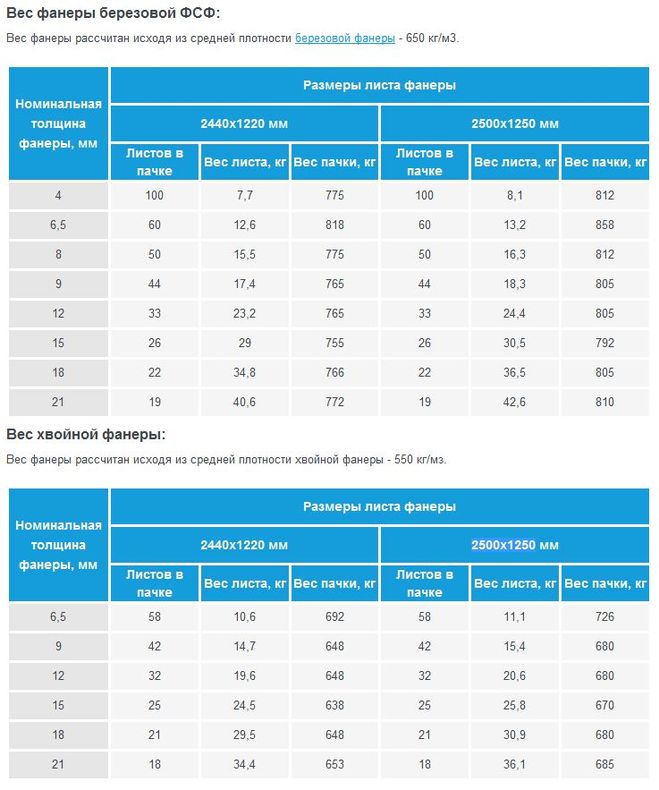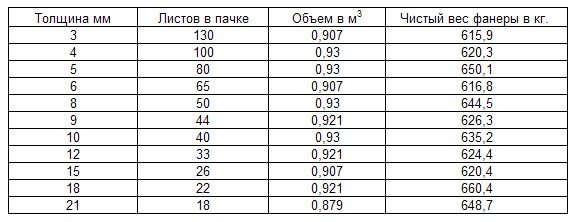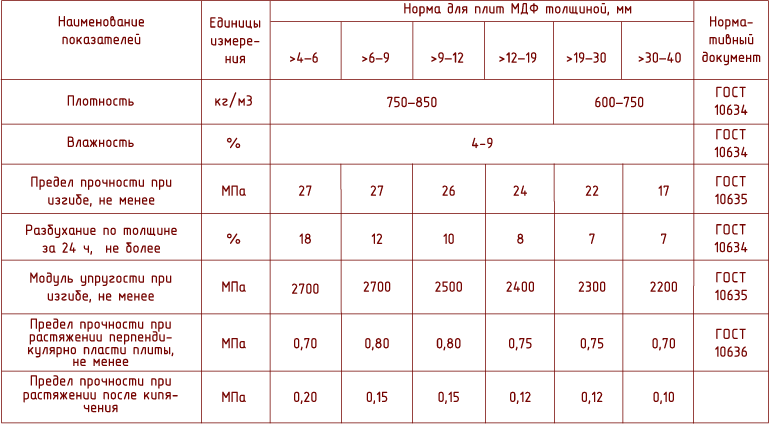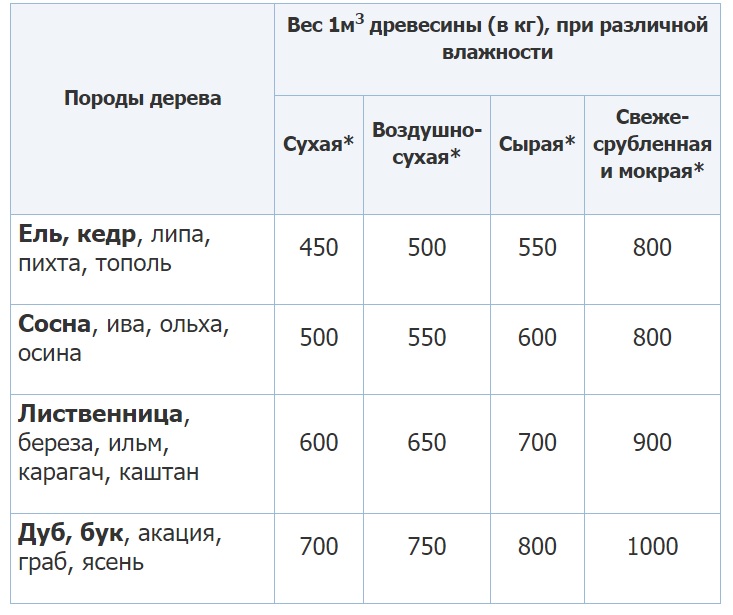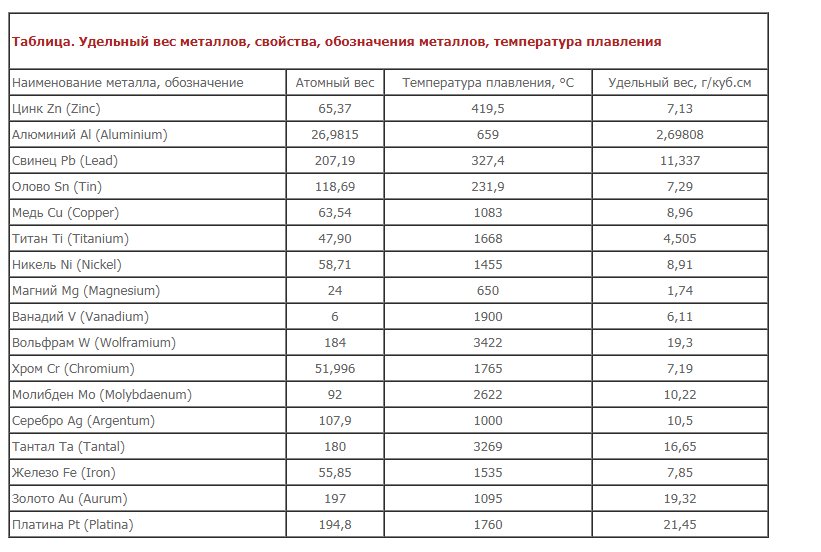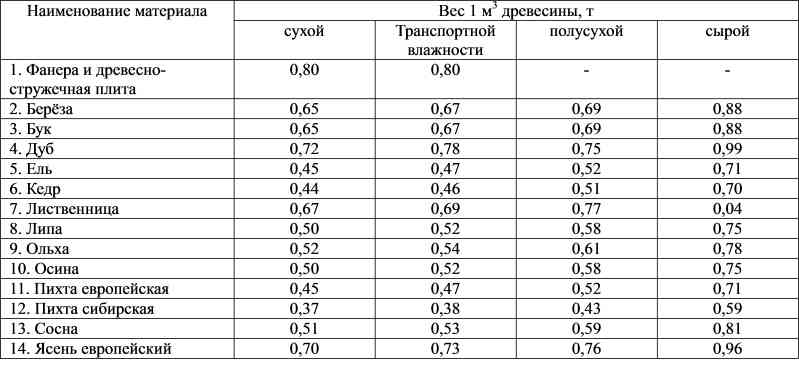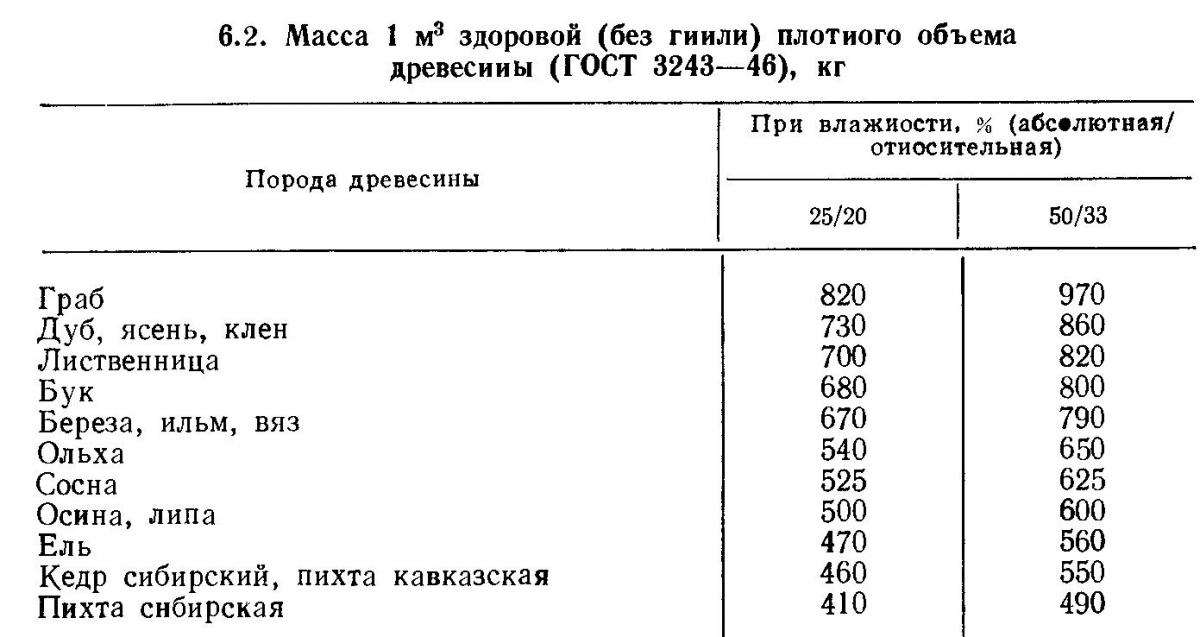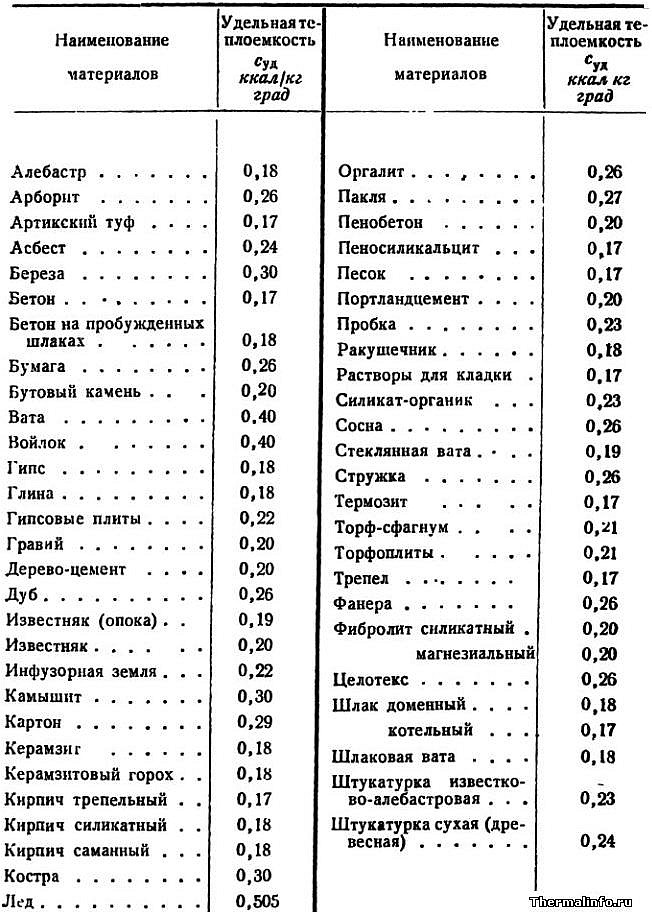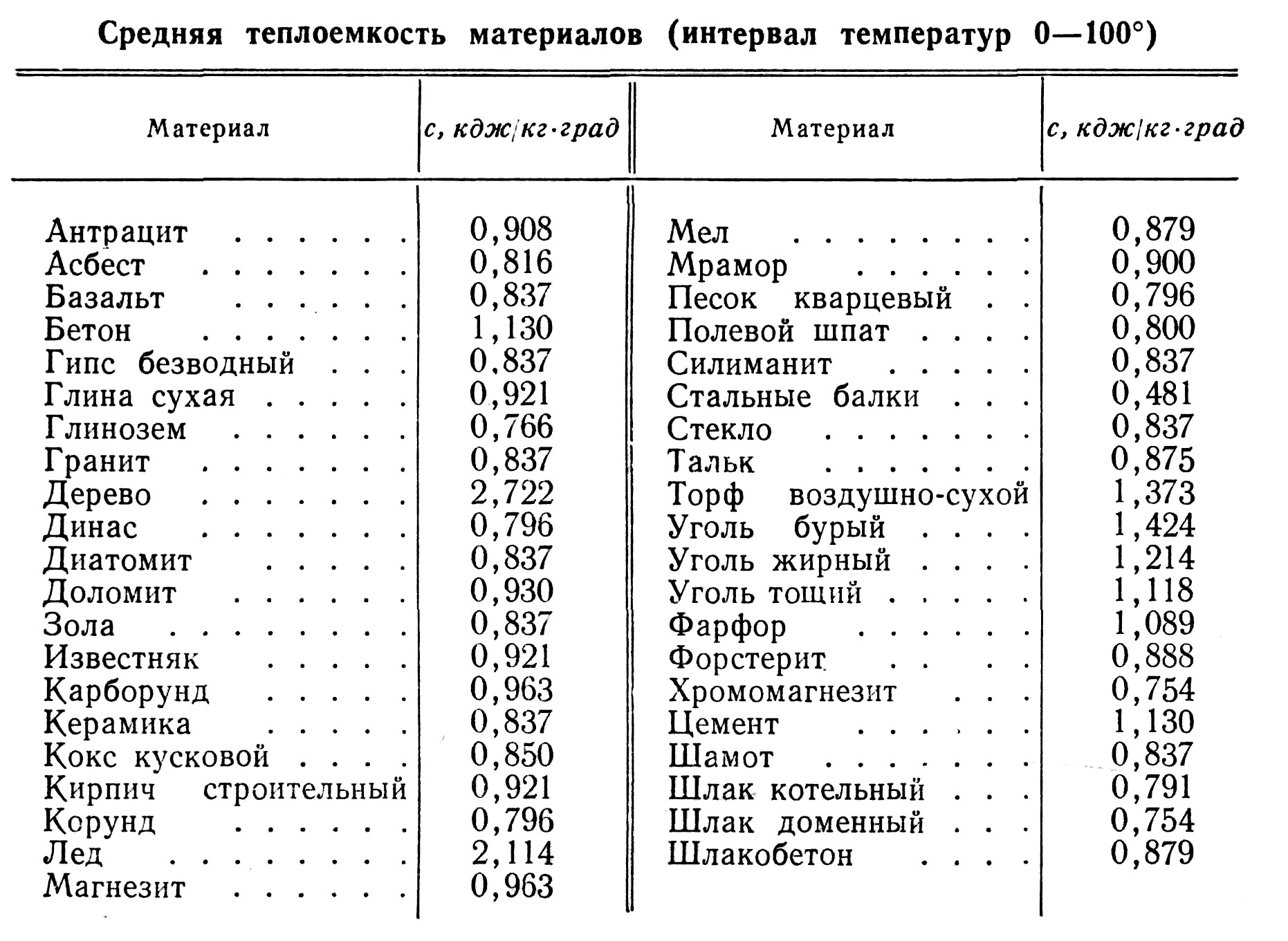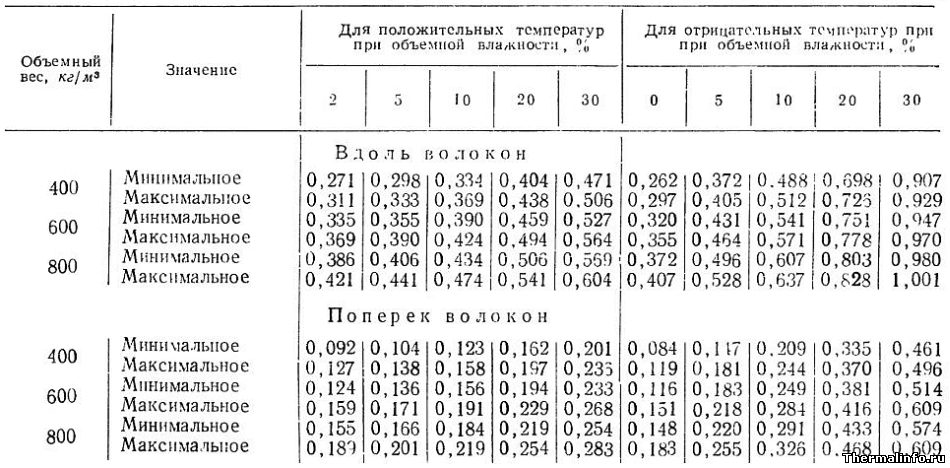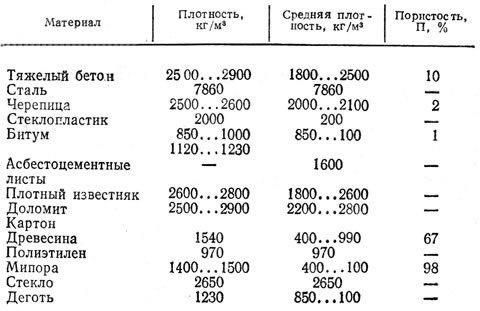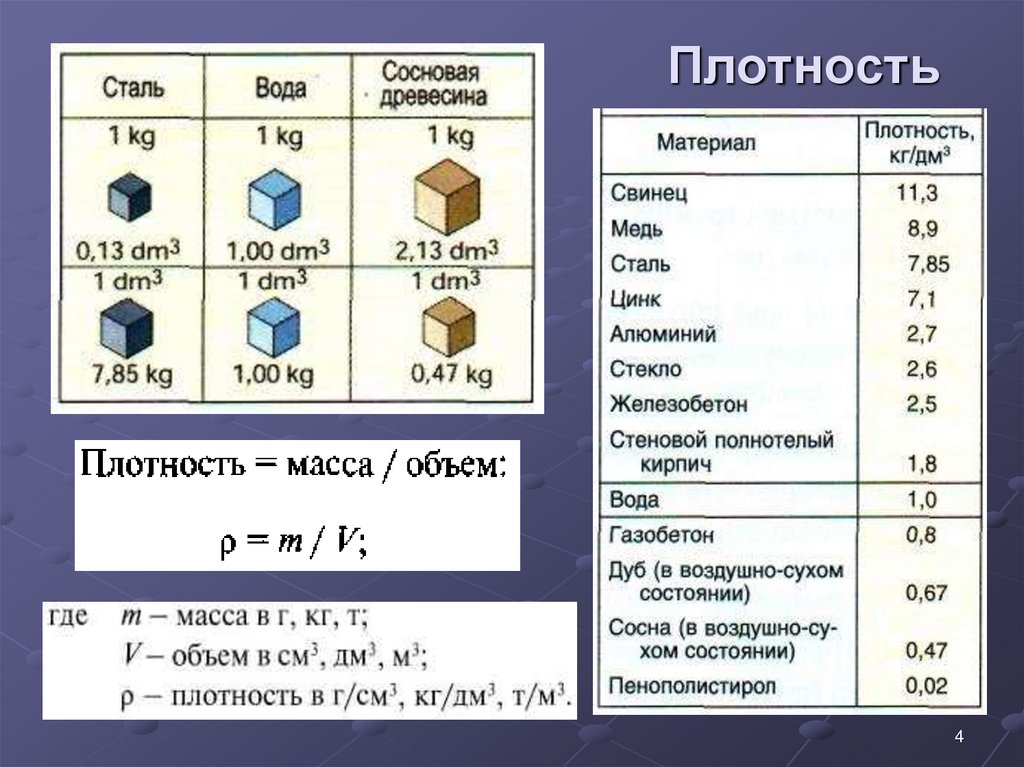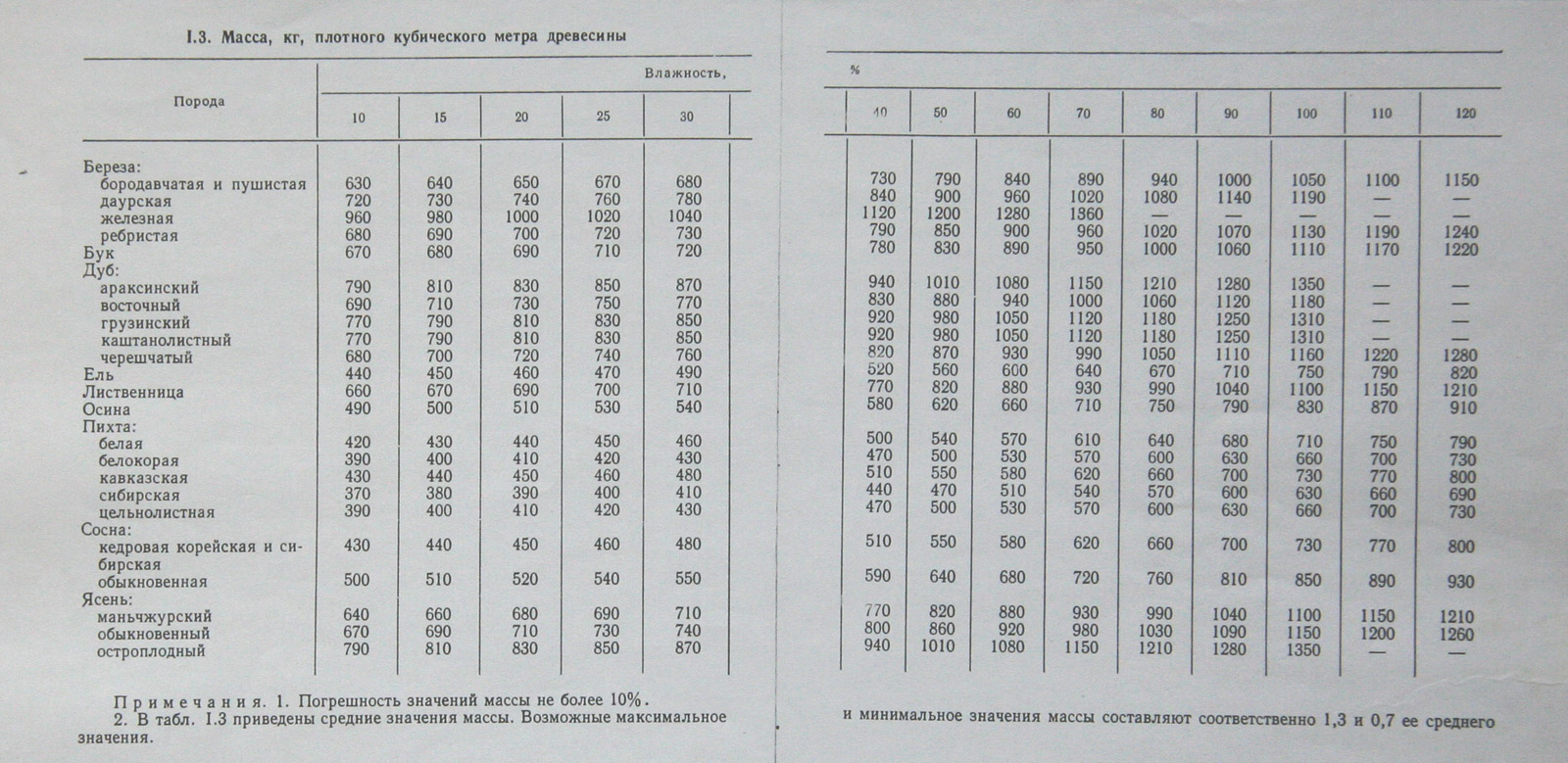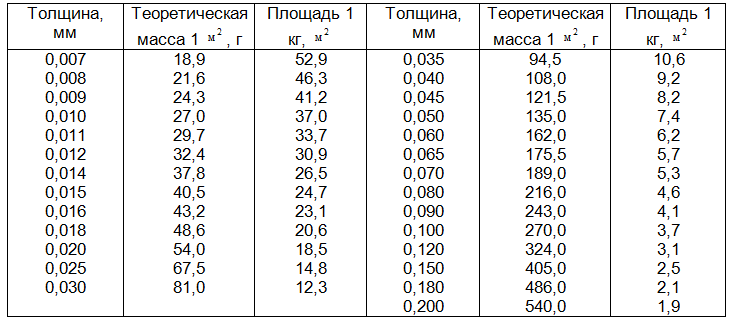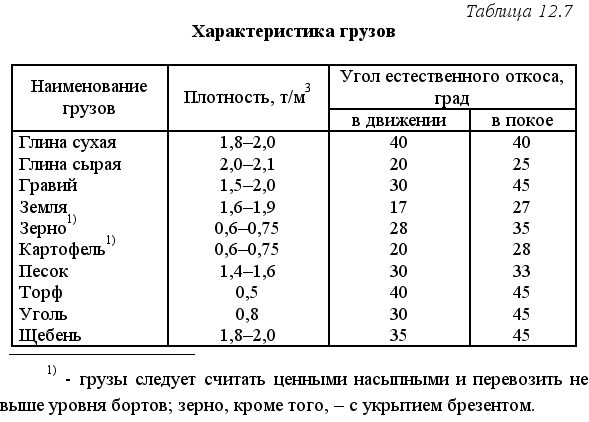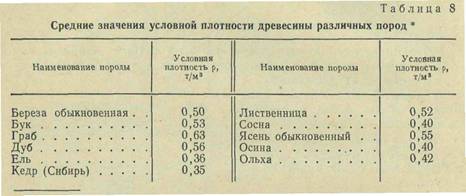Calculation of materials
The most popular types of plywood are moisture resistant (FC) and high moisture resistance (FSF). They can be made from both softwood and hardwood veneer. Their difference is determined only by the use of various adhesives that do not affect the density of the tree. If the outer sheets are birch, regardless of the inner layers, such plywood will be considered birch, if the outside is coniferous veneer - coniferous. Sometimes the inner and outer layers are made from different types of wood.
The density of coniferous plywood on average is approximately 550-650 kg / m3, and of birch or laminated plywood - 665-750 kg / m3. Specific gravity is calculated as the ratio of mass m to volume V. Accordingly, to calculate the mass of a sheet, it is necessary to multiply its volume by the specific gravity.
Plywood application table.
Sheet formats with the same thickness can be different. In this case, we are interested in plywood 10 mm thick. Let's try in practice to calculate the weight of sheets with dimensions of 1525x1525 mm and 2500x1250 mm. These are some of the most common sizes from manufacturers. Possible sizes and volumes are shown in table 1.
Let's calculate the volume of the first format V = 1.525 m × 1.525 m × 0.01 m = 0.02325625 m3.
Now we will find the minimum weight of a sheet of softwood plywood by multiplying this value by 550 kg / m3. As a result, we get 12.7909375, i.e. approximately 12.8 kg. If we take the density of wood 650 kg / m3, we get the maximum weight, it will be approximately 15.1 kg.
Let's find the weight of the same plywood sheet, but made of birch, its density will be, for example, 700 kg / m3. As a result, we get 16.279375, i.e. 16.3 kg.
The volume of the second sheet will be 2.5 m × 1.25 m × 0.01 m = 0.03125 m3. For comparison, let's calculate only the minimum weight, it is 17.1831 kg.
Birch plywood with a density of 700 kg / m3 of the same format will already weigh 0.03125 m3 × 700 kg / m3 = 21.875 kg. Thus, before talking about the weight of the sheet, you must first decide on its size.
Sometimes manufacturers indicate the mass of 1 square meter of their product. In this case, you can independently calculate its density, it will be inversely proportional to the thickness of the material, converted to meters. So you can check at the same time whether you are buying the plywood that is declared by the seller. To do this, you need to know the specific gravity of the brand you want to purchase. After making a simple calculation, just compare the results.
Product quality
Dimensions of plywood sheets.
The industry offers several varieties of products that differ in quality. It depends on what the appearance of the top layers of veneer looks like. FC and FSF can be of the first, second, third and fourth grade. The first grade is a product in which the outer sheet is perfectly smooth on both sides and has a white color. It is impossible to find knots on the products of the first grade.
The second grade has production with some drawbacks. It has slightly noticeable traces left from the repair of the upper plates, in the form of a kind of patches.
The upper layer of the third grade will have small knots on the surface with a diameter of up to 6 mm.
The fourth grade assumes the presence of knots up to 4 cm in diameter.
Film faced plywood can be of two grades - first and second. The lowest grade assumes light burns on the outside. This makes the product look unpresentable.
Properties of the material in question
To understand what plywood is, you should understand what a rotary cut veneer is:
- Sheets of this product are obtained by cutting wood on specially designed peeling machines.
- These layers are cut in a spiral about the natural axis of rotation of a natural tree in the form of a rounded log.
- This same peeled veneer is produced in sheets with dimensions of 1300x3000 mm, and the thickness of such a sheet can vary depending on the type of plywood, usually the thickness value ranges from 0.3 mm to 4.0 mm.
The main classification is based on the definition of the following list of properties:
- Application area;
- Variety;
- Brand;
- Sheet format;
- Plywood product thickness;
- Emission class;
- Design features;
- Surface treatment option;
- The type of wood used.
Density of concrete kg / m3 - Table, classification, brands!
Concrete density classification:
- Dense (1.8-2.5 t / m3)
In these solutions, the space between the granular filler is completely filled with astringent components and air (in a small amount). Accordingly, their share is higher. For example, the density of concrete B30 is 2.43 t / m3; - Porous (0.7-1.4 t / m3)
In these solutions, the space between the granular filler is filled with binder components and air bubbles formed by foaming or gassing; - Cellular (0.4-0.5 kg / m3);
Unlike the previous type, this material contains silica additives and evenly spaced pores; - Large pore (0.8-1.2 t / m3);
These mixtures contain coarse-grained and fine-grained fillers. In this case, the space between the coarse-grained aggregate is partially filled with fine fractions and a binder component.
Its specific gravity directly depends on the porosity of the material: the more air in its structure, the lighter it is.
The picture below shows the types of concrete by structure and density.
Dependence of density and strength grade
There is no direct relationship between strength and volumetric weight. The density of concrete kg m3 largely depends on the brand of cement (or other binding agent). For the preparation of dense material with a high bearing capacity, it is necessary to use high-class Portland cement (two or three levels more).
Dependence of the density of a given material on the filler
The weight of the finished structure also depends on the weight of the filler and reinforcement. For example, the density of reinforced concrete depends on the section of the reinforcement used.
When choosing this material, it must be borne in mind that its mass and strength directly depend on each other. It should also be remembered that with a greater weight of a cubic meter of material, its porosity is lower, and also its heat-insulating and sound-absorbing characteristics are less. For example, the high density of heavy concrete means that there are almost no pores in it.
Influence on properties
Most of the characteristics of the insulation are interrelated. So, the density index affects the thermal conductivity.
As you know, air is the best heat insulator. A large number of air bubbles are located between randomly directed fibers of mineral wool insulation, for example, stone wool. However, if the specific gravity of the material is increased (in fact, the fibers are compressed more strongly), then the volume of air bubbles will decrease, which will lead to an increase in thermal conductivity.
However, the relationship between density and thermal conductivity is due to the structure of the material. For example, when the density of expanded polystyrene changes, the volume of air contained in its capsules remains unchanged. This means that the thermal conductivity does not change in any way when the density of the insulation changes.
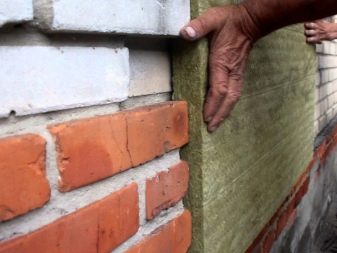

But the change in specific gravity always affects sound insulation. This is due to the fact that with a decrease in the air permeability of the heat insulator, its noise-absorbing indicators increase.
In other words, the denser the material, the better sound insulation it is characterized. However, as the density increases, so does the weight and thickness of the material. It becomes inconvenient to work with him.
The way out of this situation will be the use of special heat-insulating panels with improved sound insulation properties. It can be lightweight glass wool or basalt insulation with twisted thin and long fibers.In this case, the density of the material may not exceed 50 kg / m3.
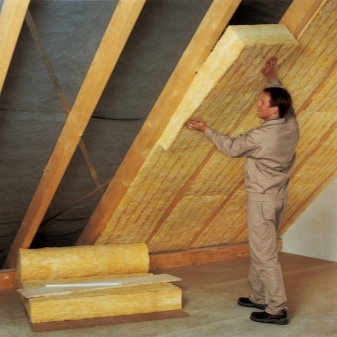

Strength indicators are also related to the material's ability to withstand heavy loads, and the relationship is directly proportional. In this regard, more dense materials should be used in the loaded areas. This is the only way to avoid deformation of the insulation.
Finally, the method of installation depends on the specific gravity of the insulation. So, between the lags and the elements of the crate, lightweight heat insulators of low density can be used. If the same option is mounted on walls, it will simply slide, so the choice is made in favor of more durable mats and sheets.
In addition, dense insulation does not need additional mechanical protection; they are strong enough to withstand mechanical stress. And looser materials - polystyrene, expanded polystyrene, mineral wool - always need additional protection.
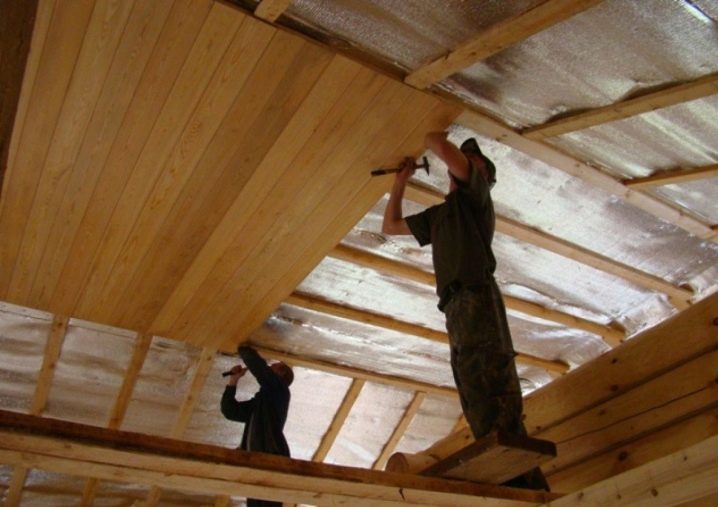
Features of useful properties
In the manufacture of plywood sheets, each manufacturer uses its own technology. For example, the core of the sheet and the veneer layers covering it can be produced from different types of wood, or they can form a single whole. In the production of the first method, hardwoods are often added to raw materials from soft woods. Pine, fir or spruce are commonly used as soft varieties. Hard species include poplar, beech, linden and birch.
Components of plywood sheets and determine their density. To have an idea of how to determine the useful properties of the boards and their area of application, it is necessary to consider in more detail the types of wood used for production.
Birch plywood
Plywood grades.
Birch wood has the lightest shade of all deciduous trees and belongs to medium-strength materials. The density of birch is about 700-710 kg / m³. This is a fairly high indicator that allows the use of birch wood not only for the manufacture of plywood, but also in the production of interior parts and household items.
Plywood sheets made from birch veneer can be successfully used as a raw material for furniture, wall panels and interior decoration. But this material is extremely undesirable to use for facade or roofing works, because, despite the high strength indicators, birch wood is prone to decay and quickly warps at high humidity.
In addition, it should be noted that birch veneer plywood sheets are very easy to process and are an ideal material for any type of finish and imitation of valuable wood species: walnut, gray maple or mahogany.
Spruce and pine slabs
Table of characteristics of birch veneer plywood.
Unlike birch, coniferous wood species are distinguished by high resin content, which gives them excellent antiseptic qualities. Plywood made from coniferous veneer is successfully used for exterior decoration and roofing works. Roof lathing or facade materials made of this type of plywood are practically not subject to decay, shrinkage and warping.
Depending on the place of growth, pine and spruce have the highest density values among conifers, which can range from 430 to 480 kg / m3. In the production of plywood boards, due to pressing, adherence to certain temperatures, the addition of paraffin, adhesives and some other factors, the density of the material can increase significantly.
Peculiarities
Plywood refers to composite building materials, for the manufacture of which various types of wood are used. It consists of several layers of veneer, which are connected with a special adhesive. Like any other building material, plywood has certain properties. It is characterized by:
- strength;
- environmental friendliness;
- flammability;
- moisture resistance;
- excellent insulating properties, among which it is worth noting thermal conductivity and moisture permeability.
But the most basic parameter that consumers pay attention to when buying and using this material is its density. The specific gravity of plywood is the ratio of the weight of the material to its volume
It depends on what kind of veneer wood the material was made from. The sheet production process is controlled by regulatory documents: GOST 3916.1-96, 3916.2-96, 11539-83. They indicate the permissible value of the density of the material - from 300 kg per m³ to 700 kg per m³.

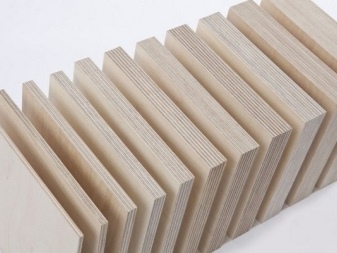
Views
Granite
Many are familiar with the scalar physical quantity of a substance (density) since school - to measure it, the mass of the substance and its volume are taken into account.
This number is several times lower than the specific gravity of crushed stone in its original state. Such a significant difference can be explained by the formation of air gaps. Because of this, the technologists themselves have derived a bulk scalar physical quantity.

Granite
One of the essential roles here is also given to the crushing fractions - when they decrease, the specific gravity increases. Therefore, the scalar physical value of the material is 20-40, several times higher than that of 40-70 (due to the fact that there are fewer air layers).
Also, the scalar physical quantity of the material exclusively in dry form is considered extremely significant. There is not only a granite product of rock crushing, as many are accustomed to think. In the construction industry, limestone, slag and gravel materials are used.
All of them stand out for their qualities and bulk scalar physical quantity. The density of crushed limestone is from 1.8 to 2.6 t / m3, the density of crushed gravel is 1.35-1.450 t / m3, the density of crushed limestone is 1.28 t / m3.
Calcareous (limestone)
Lime crushed stone stands out with its unique properties.
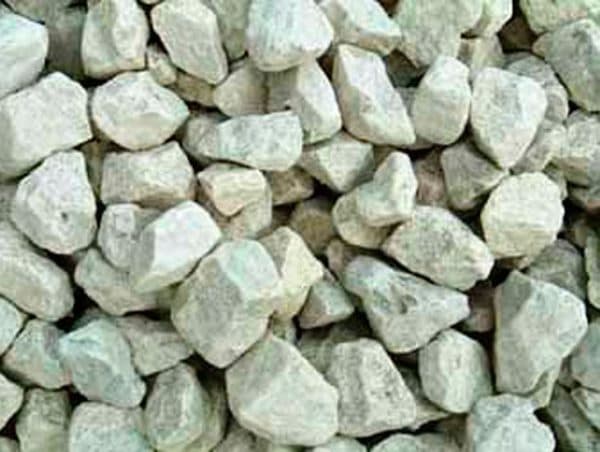
Limestone
Fractions from 5-40 mm are distinguished by the following indicators:
- bulk scalar physical quantity - 1300 kg / m3;
- flakiness - no more than twelve percent;
- the presence of remnants of dust and weak rocks - no more than two percent, no more than nine percent;
- strength grade - 600-800;
- the presence of pores - no more than 7.3%;
- the percentage of moisture accumulation, and resistance to subzero temperatures - no more than 4%, F-150;
- moisture absorption - 2.5%;
For more information about crushed limestone, see the video:
Gravel
It is more rational to use gravel as a filler for concrete and reinforced concrete structures, for the construction of monolithic objects, for overlapping objects with slabs.

Gravel
For him, the following indicators are allocated:
- bulk bulk density of building crushed stone –1400 kg / m3;
- fortress - 1200;
- resistance to subzero temperatures - F-350.

Specifications
Slag
If the crushed stone is slag, then its average scalar physical value can vary around 800 kg / m3. For strength, the required grade must be taken into account.

Slag
Strong: 800-1200, and the strongest - 1400-1600. For the secondary strength class, it can be in the border of 1.2-3 t / m3.
Black
The material in question is considered to be ordinary or fractional. It is also distinguished by the way it is produced and laid. It can be cold, warm, or hot.
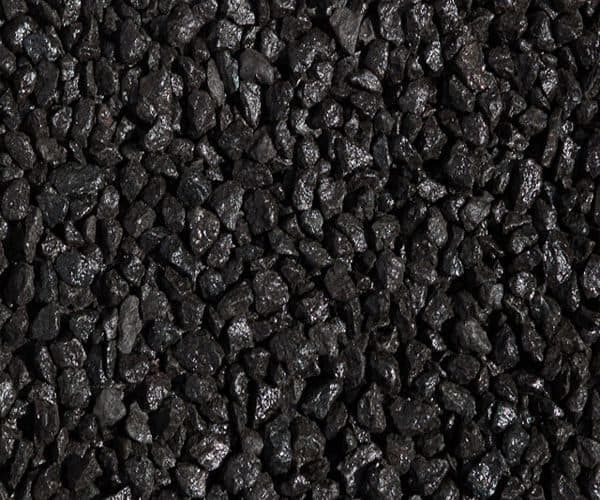
Black
By the size of the grains stand out:
- massive - 4-7 cm (wedging is necessary);
- medium - up to 2-4 cm (acceptable size);
- the smallest - up to 0.5-1.5 cm (the crumb is used in the mixture).
Cold building
The cold type is used in the repair of highways, warm and hot are difficult to underestimate for all other construction purposes.

Cold
At the same time, indicators of the volumetric weight of crushed stone of such a specific color, in other words, its scalar physical value, must be at least 2.6-3.2 t / m3, with a strength of 80 MPa.
Dolerite
What is the difference from decorative stone? You can also find a material on the market called dolerite.

Dolerite
If moisture gets on the surface of the material, a gloss immediately appears on it. It is often used as a stone for decoration in landscape design, as well as for architectural structures.
Classification of concrete density kg / m3 by brand
Any type has a brand. It is on it that everyone who buys cement needs to be guided. It consists of the letter M and the following number. In addition, there is another characteristic - class. It is usually indicated in the regulatory documents, but when ordering, buyers often distinguish between concrete by brands. The class is designated by the letter B, followed by numbers that show what kind of load the frozen solution will withstand.
Common brands:
- M100. It is used in the process of preparatory work before proceeding with the pouring of the foundation. It is used as a concrete base for curbs in road construction.
- M200. The most common brand. This solution belongs to the heavy class, the average density is 2000 kg / m3. In the composition - cement, gravel, sand. The optimal combination of strength, quality and price. Suitable for foundations of residential buildings, landscaping (construction of footpaths, sidewalks), production of concrete surfaces, stairs, slabs. This brand does not crack, it withstands pressure and temperature drops well. This determines its popularity and versatility of application.
- M250 (class B 20). The properties are almost the same as the previous brand, but the strength is higher. Able to form high load slabs.
- M300. Suitable for monolithic foundations, walls, fences, flights of stairs.
- M350 (B25). High strength, used for monolithic structures in multi-storey construction, as well as for load-bearing columns of buildings, foundations of swimming pools and airports.
The table that will be given below indicates which grade of concrete in terms of average density corresponds to a certain class.
Concrete density table kg / m3
| Class | Average strength, kgf / sq. Cm. | Brand |
| AT 5 | 65 | M75 |
| B7.5 | 98 | M100 |
| AT 10 | 131 | M150 |
| B15 | 196 | M200 |
| IN 20 | 262 | M250 |
| B25 | 327 | M350 |
| B30 | 393 | M400 |
| B35 | 458 | M450 |
| B40 | 524 | M550 |
| B50 | 655 | M600 |
| B60 | 786 | M800 |
How to influence volumetric weight?
The density of the concrete monolith is largely determined by the characteristics of the components of the mixture
It is their selection that attention should be paid to in order to obtain the desired weight of the concrete solution at the output. Moreover, the actual composition and ratios in the recipe are far from the only decisive factor.
More than half of the mass of concrete falls on a large aggregate, therefore, it is initially necessary to determine its own weight and even bulk density. The latter will show how many air pockets for sand and cement are left inside, but the mass of stones will make a much more serious difference. For example, if the composition of B25 includes granite or dolomite crushed stone with the strength of M600, its own density will be so high that the concrete will turn out to be at least D2200-2400. And pumice, expanded clay and tuff will give only a lightweight type of monolith no heavier than 1.6-1.8 t / m3.
The density of the cement monolith can be changed with the help of other components of the solution, but not so noticeably. For example, the increase in weight is caused by the use of aggregates fines. And do not forget about special plasticizers that improve the fluidity of the mixture, while reducing the amount of liquid in it.
Birch wood
Plywood production line.
Birch is ubiquitous in forests in the Russian Federation and neighboring European countries. It can be handled well with hand and power tools. It is planed, milled, cut with a knife, bent. Possessing a high specific gravity, it splits poorly from an ax blow, especially when raw, and perfectly holds all types of fasteners in its body.
Its trunk is narrow and often curved, the wood is knotty, and the wood is almost unsuitable for making high quality planks or beams. Birch has another drawback.It strongly absorbs moisture and is affected by fungal diseases, from which it quickly becomes unusable.
Plywood production involves the impregnation of sheets with adhesives, which give the tree water resistance and protection against fungal infections. Various types of birch wood with technical value are used for the manufacture of veneer. The resulting thin sheets are particularly flexible and durable. The plywood made from birch has a beautiful white texture.
Depending on the adhesive bases used, the products may carry different markings, which do not affect the density. If the sheet belongs to FC, then this designation indicates the type of plywood product with average moisture resistance, which is obtained when using urea glue, which does not bring any particular harm to the body.
FSF marking indicates the use of formaldehyde resin glue, which improves the water resistance of the material, but worsens its environmental qualities. This type of glue was specially created for the possibility of using products for outdoor work.
Finished products are widespread due to their increased strength, wear resistance, moisture resistance, ease of processing and quick installation. All these qualities are possessed by plywood sheet due to its high density, ranging from 650 to 750 kg / m³ with a relative humidity of wood of 12-15%.
Features of various woods
Thickness and durability of general purpose plywood.
For the manufacture of plywood sheets, a variety of tree species can be taken: needles (larch, fir, pine, spruce), birch, oak, linden, beech, poplar. Wood is soft and hard. The density is higher for birch, beech, poplar. Birch sheets are very popular and respected among builders. Birch wood has a light shade (white or yellowish), the strength and hardness of this material is average. All the described criteria, together with the density, make it possible to find the use of one or another type of material in the construction business.
The density of birch plywood is about 700 kg / m³. If we compare this indicator with conifers, then it is slightly higher. This indicates that birch sheets of this density can be successfully used for interior decoration and furniture construction.
It is important that sheets of this type should not be used for external work. They are not suitable for decorating the facade due to the fact that they are capable of decay
Despite the high density, such plywood sheets are afraid of moisture.
Density of needles
Softwood plywood is the most readily available for consumers. The most common types of wood are pine and spruce.
Characteristics of moisture resistant plywood.
The growing region has a great influence on the density. Like birch, pine is highly durable
It is also important that it injects well. Pine is distinguished by the fact that there is a lot of resin in it, this protects it from destruction by a putrefactive fungus, as a result of which its service life is longer
Sheets made from pine are lighter. It has been established that the density depends on the mass of the wood and its volume. Pine has a low weight, so such plywood will be less dense.
Externally, coniferous plywood is not uniform in color. It has a somewhat striped outline. Spruce-based sheets are another variety. Spruce is a tree that grows almost everywhere in Russia. This is the most affordable and cheapest product. Its density index practically does not differ from that of pine. The density of spruce coniferous leaves ranges from 450 to 470 kg / m³. Spruce lends itself to processing worse than pine. It has many knots and less resin. Despite this, pine and spruce plywood is actively used to equip building facades in the open air. Often, such plywood boards serve as the basis for the construction of roof sheathing.
Output
A scalar physical quantity is extremely important for construction, therefore, at the stage of construction of structures, it is important to take into account all the indicators described in the article. The compaction factor of the material must be determined by the manufacturer and indicated in all relevant documents that accompany all batches.
It is often necessary to determine the aggregate compaction ratio during ramming and on the construction site. It is more rational to carry out measurements using a density meter. This will justify the goals set if the material contains no more than 15% grains, which do not exceed ten millimeters.

